It’s no easy task to plan a trip to Gates of the Arctic National Park, but have no fear. Below you’ll find the ultimate guide to Gates of the Arctic National Park, including how to get there, when to visit, things to do, and more.
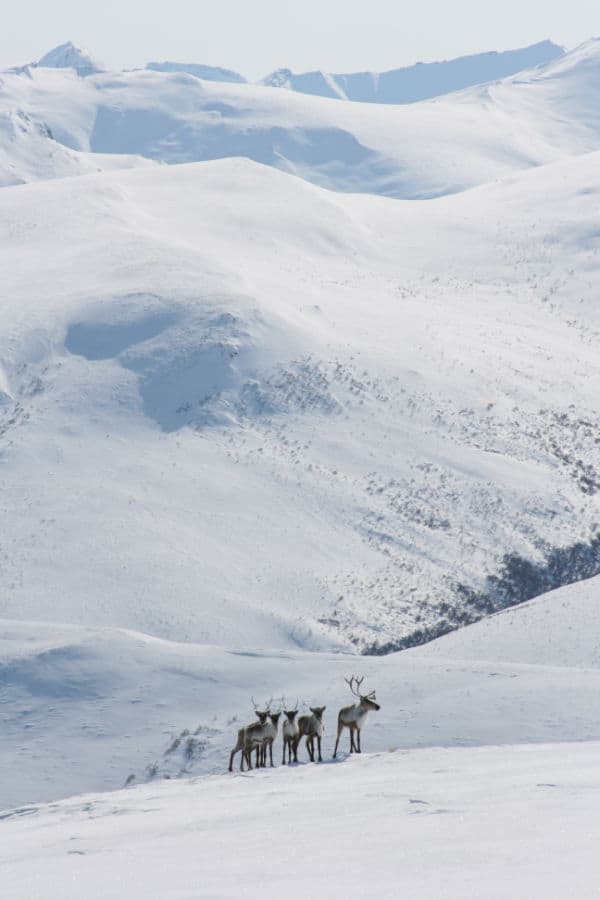
Gates of the Arctic National Park
Gates of the Arctic National Park is one of the few remaining wild expanses on the planet. Its remote location above the Arctic Circle, combined with the challenging terrain, makes this America’s least-visited national park.
Still, those who do make the journey to Gates are rewarded with some of the world’s most spectacular scenery - all without the crowds.
About Gates of the Arctic National Park
From the towering mountain peaks and large swaths of boreal forests to the tundra, taiga, and six wild and scenic rivers - this is wild Alaska in its purest form.
There are no roads, trails, or designated camping areas in the park, so backcountry and wilderness survival skills are a must when visiting Gates of the Arctic National Park.
Even the most seasoned adventurers often opt to take guided tours of this park, and there’s no better way to fully immerse yourself confidently in all this wild area has to offer.
Is Gates of the Arctic National Park worth visiting?
Perhaps nowhere else on earth is still as wild as Gates of the Arctic National Park, and the rugged beauty of this area is absolutely worth checking out.
That being said, there’s a reason that this is the least visited national park in the country - it’s incredibly difficult to get to and even more challenging to navigate once inside.
Those who want to cross this incredible park off of their bucket list will need to have experience in wayfinding, backpacking, and wilderness survival or the money to book a guide.
Visiting this park will take lots of planning and preparation, but it’s the trip of a lifetime that very few can say they’ve completed.
History of Gates of the Arctic National Park
The human history of the park dates back more than 13,000 years. Ancient Inupiaq and Athabascan nomadic tribes once traversed his abundant area, fishing the streams and hunting for caribou and other wildlife.
Ancestors of these tribes still live in small communities around the park, the largest of which is Anaktuvuk Pass.
In more recent history, the area enticed early explorers, scientists, and gold miners.
The park got its name from conservationist Robert Marshall in 1929 while he was exploring the North Fork of the Koyukuk River. The mountains surrounding the river appeared gate-like, and the nickname ‘Gates of the Arctic’ stuck.
The area became a protected national monument in 1978 and was upgraded to national park and preserve status in 1980.
Things to know before your visit to Gates of the Arctic National Park
Gates of the Arctic National Park Entrance Fee
Park entrance fees are separate from camping and lodging fees.
Gates of the Arctic National Park does not charge an entrance fee!
Time Zone
Alaska Time
Pets
Pets are allowed in Gates of the Arctic but they must be on a leash less than 6 feet in length or crated.
Both communities of Bettles and Anaktuvuk Pass have strict pet leash policies.
Cell Service
There is no cell phone service
Park Hours
Open 24 hours
Wi-Fi
No public wifi available.
Parking
There are no roads in the park. The only parking will be at the flight services centers.
Food/Restaurants
There are no amenities or services
Gas
There are no amenities or services
Drones
Drones are not permitted within National Park Sites.
Don't forget to pack
Don't forget to pack
Insect repellent is always a great idea outdoors, especially around any body of water.
We use Permethrin Spray on our clothes before our park trips. Please read my article on preventing biting insects while enjoying the outdoors.
Sunscreen - I buy environmentally friendly sunscreen whenever possible because you inevitably pull it out at the beach.
Bring your water bottle and plenty of water with you. Plastic water bottles are not sold in the park.
Sunglasses - I always bring sunglasses with me. I personally love Goodr sunglasses because they are lightweight, durable, and have awesome National Park Designs from several National Parks like Joshua Tree, Yellowstone, Hawaii Volcanoes, Acadia, Denali, and more!
Click here to get your National Parks Edition of Goodr Sunglasses!
Binoculars/Spotting Scope - These will help spot birds and wildlife and make them easier to identify. We tend to see waterfowl in the distance, and they are always just a bit too far to identify them without binoculars.
Details about Gates of the Arctic National Park
Size - 7,523,897 acres
Gates of the Arctic NP is currently ranked at 2 out of 63 National Parks by Size.
Date Established
December 1, 1978 - Designated as a US National Monument
December 2, 1980 - Redesignated as a National Park and Preserve
Visitation
In 2021, Gates of the Arctic NP had 7,362 park visitors.
In 2020, Gates of the Arctic NP had 2,872 park visitors.
In 2019, Gates of the Arctic NP had 10,518 park visitors.
Learn more about the most visited and least visited National Parks in the US
National Park Address
Park Office - NOT THE PARK
101 Dunkel St
Fairbanks, AK 99701
National Park Map
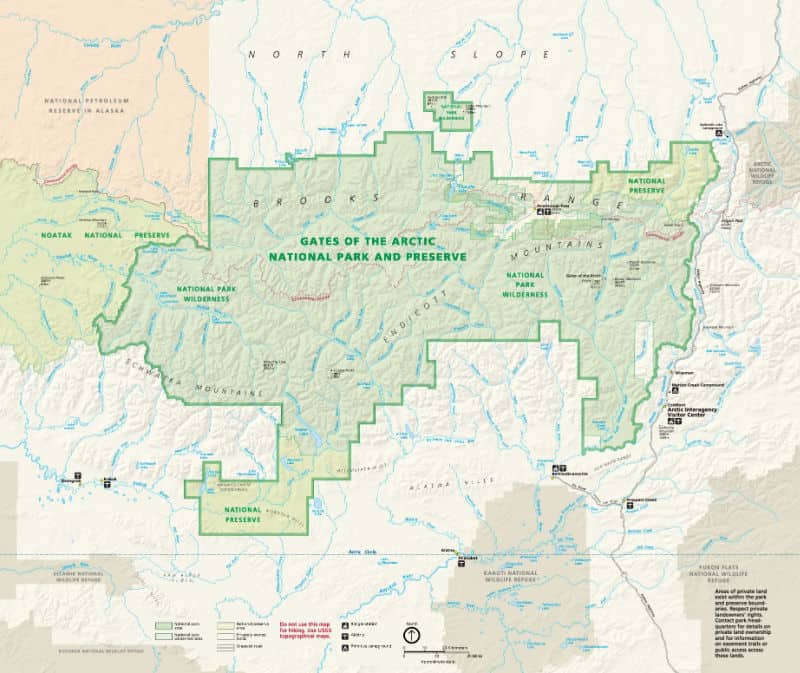
For a more detailed map we really like these National Geographic Trails Illustrated Maps on Amazon
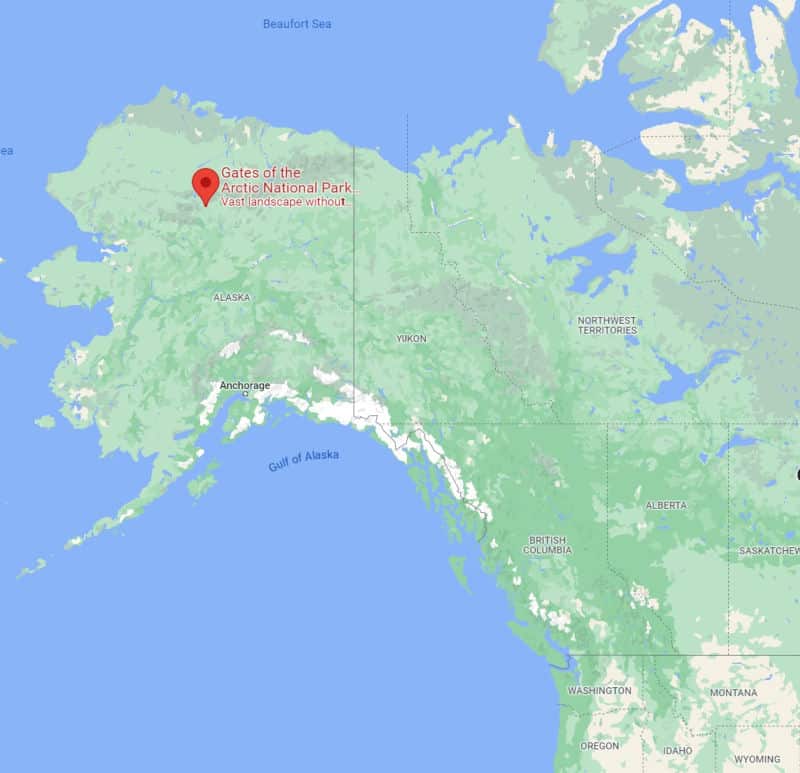
Where is Gates of the Arctic National Park?
Gates of the Arctic NP and Preserve is located in remote Northern Alaska.
Estimated distance from major cities nearby
Estimated Distance from nearby National Park
Each of these Alaska National Parks would need to be reached by plane. There are no roads connecting the parks.
Wrangell St Elias National Park
Where is the National Park Visitor Center?
Fairbanks Alaska Public Lands Information Center
This visitor center is inside the Morris Thompson Cultural & Visitors Center in Fairbanks, Alaska.
Bettles Ranger Station and Visitor Center
This ranger station is located outside of the Gates of the Arctic NP & Preserve in Bettles, Alaska.
Arctic Interagency Visitor Center
Located on the Dalton Highway in Coldfoot, Alaska
Anaktuvuk Pass Ranger Station
Staffed during the summer from April through September.
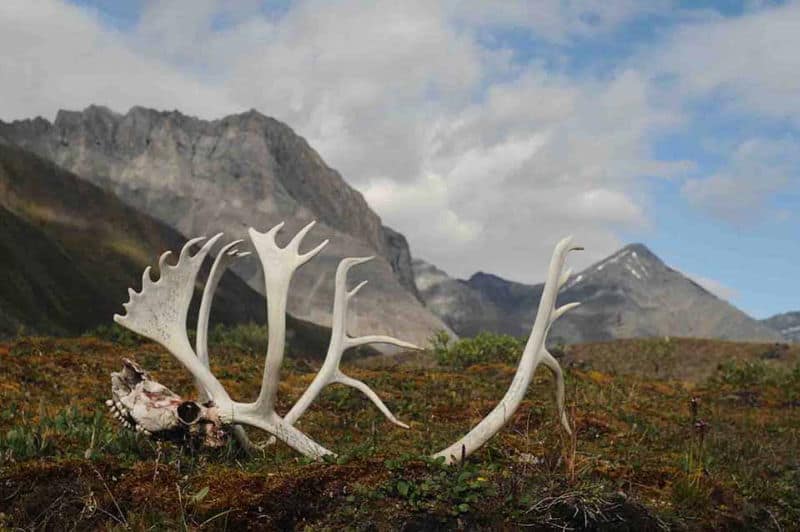
Getting to Gates of the Arctic National Park
Closest Airports
Fairbanks International Airport - From Fairbanks you will need to schedule a flight to Bettles, Anaktuvuk, or Coldfoot.
Driving Directions
There are no roads or trails into the park. Visitors must fly, hike, or float into the park.
If you decide to hike in, you’ll need to drive along the Dalton Highway, which leads north from Fairbanks and eventually along the park's eastern edge.
You can park along the side of the highway and hike in from there, or make a pit stop in Coldfoot to check out the visitor center and ask for suggestions.
Best time to visit Gates of the Arctic National Park
Winter is the longest month at Gates of the Arctic, and temperatures usually hover at or below freezing for at least half of the year.
This means that summer is the best time (if not the only time) to visit the park.
No matter what season you visit, you can almost depend on the unpredictable weather, so it's a good idea to dress in lots of layers and be prepared for storms, freezing rain, or even hot sunny days.
Weather and Seasons
Spring
Spring is a difficult time to visit the park, as much of this season is really just an extension of winter.
Temperatures drop well below freezing in the evenings, and there’s no telling how much or how little snow might be present during these months.
Summer
Summer is by far the best time to visit Gates of the Arctic. Flowers begin to bloom, wildlife is more active (and therefore more visible), and hiking through the park is once again possible without the impediment of snow.
Accessing the park is also much easier during the summer, with small commercial flights regularly scheduled to Bettles from Fairbanks.
Note that if you visit in the summer, you will have endless hours of sunlight thanks to the park’s location near the Arctic Circle.
July is typically the warmest month, with highs peaking between 60 and 70 degrees Fahrenheit.
That being said, this is also the wettest month of the year, and the hoards of bugs that come with the summer showers are no joke.
Late summer and early fall are the best times to visit, as these are the dryest months, and most of the bugs have disappeared.
Fall
Just like the spring, autumn is a difficult season to plan for. It is often just an early extension of winter, and temperatures are usually not very welcoming.
Early September is the best month to visit if you want to see the fall foliage at its peak, though you may have a hard time arranging a bush plane as hunters swarm to the park during this time as well.
Winter
If you have your heart set on visiting in the winter, you will need to be well versed in arctic survival.
Temperatures can sink below -40° Fahrenheit, and darkness encapsulates the park for nearly 24 hours a day - which kind of defeats the purpose of seeing the park. A few guided trips are available during the winter months for cross-country skiing and dog mushing.
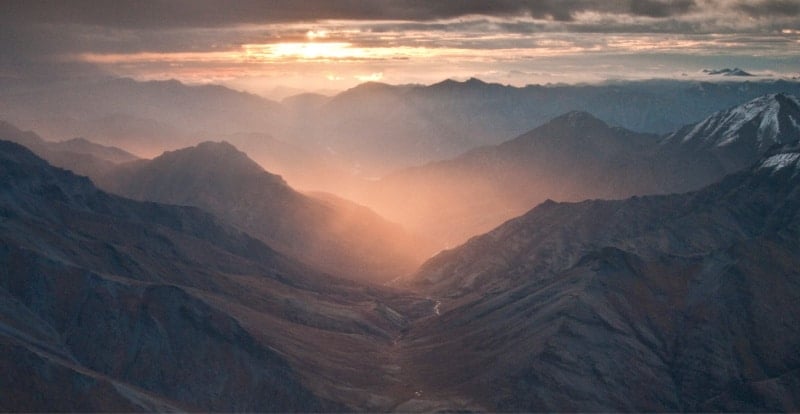
Best Things to do in Gates of the Arctic National Park
Wildlife viewing
Due to its limited interaction with the outside world, Gates of the Arctic is home to a large population of wildlife, including grizzly bears, Dall sheep, moose, wolves, numerous bird species, and the massive Western Arctic Caribou Herd - which contains over 200,000 members and migrates through the ark twice a year.
Although these creatures live all around the park, you may only see evidence of their existence in footprints, discarded antlers, or rubbed trees.
So don’t be chagrined if you don’t spot any wildlife during your trip to Gates. After all, there are worse things than missing out on a Grizzly bear encounter!
Junior Ranger Program
The Junior Ranger program gives visitors of all ages the opportunity to learn more about permafrost, the Brooks Range gold rush, and more.
The program can be done online if you are unable to visit the park. Visit this page for more info.
Birding
Birdwatching at Gates of the Arctic National Park is great, and over 140 species have been seen and heard in the park over the last 30 years.
Many migrate here during the summer for the endless hours of daylight, including aquatic birds, raptors, songbirds, and more. There are also a few species that reside here year-round, including the ptarmigan.
Explore the Wild and Scenic Rivers
Experienced paddlers are welcome to explore the park’s numerous rivers, six of which have officially been dubbed Wild and Scenic. Kayaking, canoeing, and rafting are great ways to see the park, though you will need to pack your own gear with you.
Most charters do not allow you to haul rigid watercraft aboard, so inflatable, foldable, and lightweight options are your best bet if you hope to float these rivers.
Kayakers and canoers will love the calm waters of the Alatna and Noatak rivers, and whitewater rafters will find more challenging rapids to the west and the north along the Kobuk and Nigu rivers.
You can adventure in the rivers solo or hire an experienced guide in one of the park’s gateway cities. Just be sure to do so well in advance as these tours get booked up quickly.
Hiking in Gates of the Arctic National Park
Always carry the 10 essentials for outdoor survival when exploring.
Although there are over eight million acres of park land to explore, you won’t find any designated trails inside Gates of the Arctic.
Instead, hikers will need to rely on their own wayfinding, bushwacking, and river crossing skills.
Traversing this terrain is not for the faint of heart, and even experienced backpackers consider making six miles a day a great success. When you can, try to stick to game trails or ATV trails to minimize your impact along the park’s fragile ecosystem.
Due to the extreme difficulty and endless options for routes, many visitors choose to hire a private guide to lead them around the park.
Guided expeditions are a great way to ensure a successful trip through Gates of the Arctic, though options are limited and sell out extremely quickly during the summer months.
Which areas to see in Gates of the Arctic National Park?
It would be mighty ambitious (and all but impossible) to explore the entire 8.4 million acres that constitute Gates of the Arctic National Park, so it’s important to plan ahead and decide which areas you want to see.
Below we’ve highlighted some of the best and most beautiful places in the park, but know that your options here are truly endless.
Alatna River Valley & Arrigetch Peaks
Located in the southwest of the park, this stunning area is one of the most popular spots in the park.
The spectacular Arrtigtech Peaks are a sight for sore eyes and likely sore legs, too.
Most visitors get dropped off around Circle Lake and then hike the rest of the way, following the Wild and Scenic Alatna River, which leads directly to the peaks.
Anaktuvuk Pass
Those interested in the history and culture of the Inupiaq people will not want to miss Anaktuvuk Pass.
This village is inhabited mainly by the nomadic Nunamiut people and is home to the Simon Paneak Memorial Museum - a great place to learn about this people’s history and culture.
This small village is also a great jumping-off point for the North Fork of the Koyukuk River and the John River.
North Fork Koyukuk River & The Gates
If you only have time to explore one area of the park, make it this one.
Two towering mountains (Frigid Crags and Boreal Mountain) rise up along the river, and these are “the gates” for which the park was named.
Kobuk River
To get the most out of your time in the Alaskan Wilderness, you could always knock out two parks with one stone.
The Kobuk River flows west from the Endicott Mountains in the Brooks Range and eventually dumps into the Kotzebue Sound. Along the way, it traverses into Kobuk Valley National Park, and experienced paddles have been known to make this journey by pack raft.
Kuyuktuvuk Creek
This is a popular port of entry for those who choose to hike in from the Dalton Highway.
Once inside the park, the creek makes it easy to navigate, and it’s also a great route marker leading all the way to the Itkillik River. It’s also an incredibly scenic area with domineering mountain peaks all around.
How to beat the crowds in Gates of the Arctic National Park?
As one of the last truly wild places on earth, Gates of the Arctic is one of the most remote and difficult to access parks in the nation.
As a result, it is usually the least visited national park in the entire system, which means those who make the journey here won’t have to worry about crowds.
That being said, it is important to plan and book your trip well in advance, as charter planes and guided journey’s to the park can fill up quickly during the summer and autumn months.
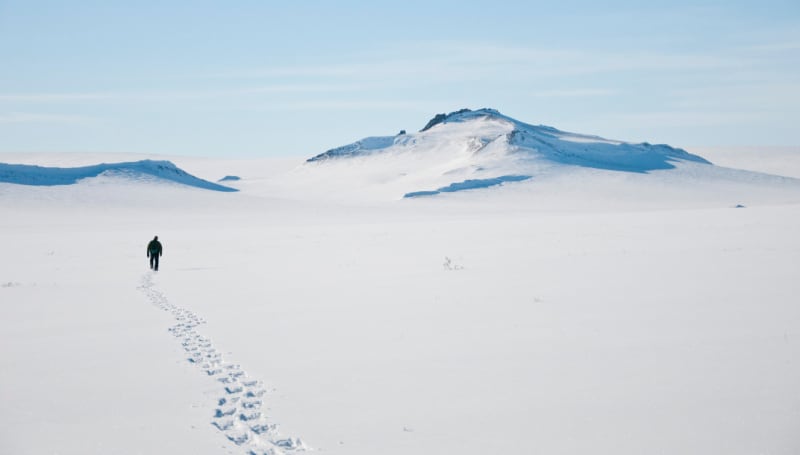
Gates of the Arctic National Park, Alaska
Where to stay when visiting Gates of the Arctic National Park
There are no National Park Lodges in Gates of the Arctic NP.
Springhill Suites by Marriott Fairbanks - I have stayed here a couple times in the past and was really liked this hotel. It has nice comfortable beds, clean and easy to get to. They offer free WIFI, continental breakfast, has a pool and a gym and a free shuttle to the airport.
Click here to book your stay at the Springhill Suites by Marriott Fairbanks.
Camping
There are no designated campgrounds or sites inside the park, but that doesn’t mean you can’t pitch your tent and stay the night.
Backcountry camping is allowed, though it will require lots of planning and preparation - staying overnight in the arctic is no easy feat!
The best place to set up camp is on a hard surface, specifically a gravel bar. Not only does the gravel provide a flat and compact surface for your tent, but it also ensures that you don’t destroy any of the park’s fragile ecosystems.
Just be sure to pitch your tent well above the waterline, as the river can rise quickly. If you do have to set up camp in the tundra, try to find a spot that has already been impacted by other campers whenever possible.
Fires are allowed as long as there is no fire ban in place, though propane or gas cooking stoves are usually more practical than building a fire in the backcountry.
Remember that you are in bear country, so you'll need to prepare and consume your meals at least 100 yards from your camp and store any food in bearproof containers.
More detailed information about backcountry camping at Gates of the Arctic can be found on the National Park website.
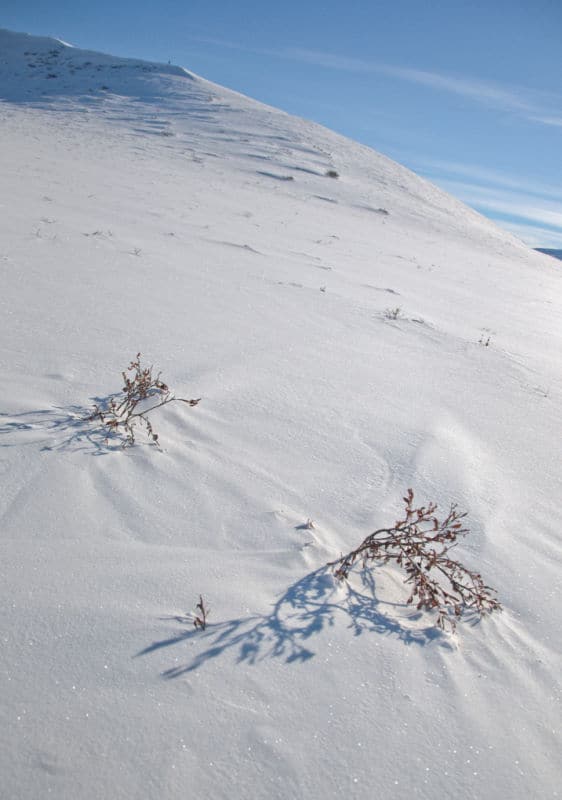
Parks Near Gates of the Arctic National Park
Complete guide to Denali National Park
Klondike Gold Rush National Historical Park
Sitka National Historical Park
Aniakchak National Monument and Preserve
Bering Land Bridge National Preserve
Cape Krusenstern National Monument
Check out all of the Alaska National Parks along with National Parks in Washington, California National Parks, and National Parks in Hawaii
